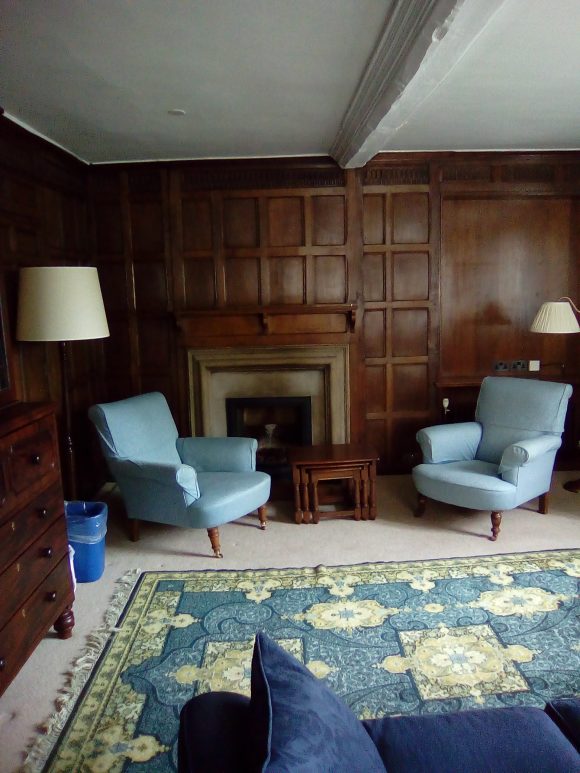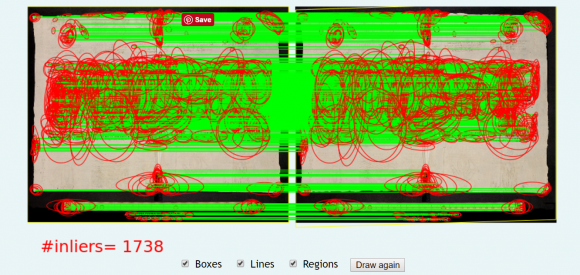By Jacqueline Reid-Walsh
A short time ago I had the opportunity to see inside Anthony Wood’s house and walk around Merton College. Since the house had been leased by his family for generations he lived here all of his life. My gracious host was Dr. Julia Walworth, the Fellow Librarian at the college. Previously I had walked by “Postmasters” house or “Portioners’ Hall’ (nothing to do with mail!) on Merton street but had not seen the interior. The building is presently used by Merton for classes and conferences, while the upstairs is where visiting scholars are housed. Since the university is now on break between terms the house is not currently being used so we were able to see inside. It is a largish medieval cottage renovated in the 17th century and subsequently divided for the present use. Looking around the beautifully maintained dark beamed, high ceilinged rooms on the upstairs two floors I felt like I was on international academic housefinders!
Woods’ living quarters are described in the DNB article by Graham Perry, based on Woods’ autobiography, in the following way:
In February 1660 he improved the upper story of the family house opposite Merton, putting in a fireplace in one room and throwing out a window over the street in the other, so making himself a two-room hermitage where he conducted his studies for the rest of his life.
Although the house now has a renovated attic—I wondered did he use it for storage–? I presumed that Wood lived on present second floor, composed of two good sized rooms, while his brother and wife lived downstairs. Looking around the larger paneled room, with beautiful carved moldings and large storage chest, I wondered where he put his books and more especially where he put his ballads that he collected and placed in bundles. It was a beautiful airy and bright space with lovely views over the street to Merton.
Wood and his family are buried at Merton and there is a plaque in the chapel devoted to him. The house is opposite the main entrance to the college. We walked across the narrow picturesque street, through the porter’s entrance and stone walkways to the exquisite grounds. Quite near the front entrance is a beautiful, large chapel with ancient stained glass windows. I gazed at the plaque in the entrance hall of the church. It was restrained yet emotionally moving to look at.
From entering these two spaces I felt I had connected in some way with the great collector and historian. The experience of entering his work and living space makes him more tangible as a scholar and a person. I could imagine him, when not reading in the splendid Duke Humphrey’s library at the Bodleian, here in this comfortable space devotedly working on his histories of Oxford and organizing his collections of ballads that was a recreation from his serious labour. Here in these surroundings I could understand his thoroughness in including a unique broadside that is the turn-up strip “the beginning, progress and end of Man”, carefully annotating the date and placing it amongst his bundles of ballads. I only wish he had added a comment or doodle to as he had done on a number of other items to reveal a personal insight!
Clark, Andrew, ed. The Life and Times of Anthony Wood, Antiquary of Oxford, 1632–1695, Described by Himself. I. Oxford: Clarendon Press, 1891.
Kiessling, Nicolas. The Library of Anthony Wood. Oxford: Bodleian Library, 2002
Parry, Graham. ‘Wood, Anthony (1632–1695)’, Oxford Dictionary of National Biography, Oxford University Press, 2004; online edn, Jan 2008 [http://www.oxforddnb.com/view/article/29864, accessed March 24,17]
http://www.oxfordshireblueplaques.org.uk/plaques/wood.html
Photos of Postmasters’ Hall with the kind permission of The Warden and Fellows of Merton College Oxford’

















